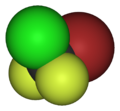| |||
| Names | |||
|---|---|---|---|
| Preferred IUPAC name Bromo(chloro)difluoromethane | |||
| Other names Bromochlorodifluoromethane Halon 1211 Halon 1211 BCF BCF Freon 12B1 | |||
| Identifiers | |||
3D model (JSmol) | |||
| ChEBI | |||
| ChemSpider | |||
| ECHA InfoCard | 100.005.944 | ||
| EC Number |
| ||
PubChem CID | |||
| UNII | |||
CompTox Dashboard (EPA) | |||
| |||
| |||
| Properties | |||
| CBrClF2 | |||
| Molar mass | 165.36 g/mol | ||
| Appearance | Colorless gas | ||
| Density | 7,1362 kg·m−3 (15 °C, 1 bar) | ||
| Melting point | −159.5 °C (−255.1 °F; 113.6 K) | ||
| Boiling point | −3.7 °C (25.3 °F; 269.4 K) | ||
Except where otherwise noted, data are given for materials in their standard state (at 25 °C [77 °F], 100 kPa). | |||
Bromochlorodifluoromethane (BCF), also referred to by the code numbers Halon 1211 and Freon 12B1, is a haloalkane with the chemical formula C F 2 Cl Br. It is used for fire suppression, especially for expensive equipment or items that could be damaged by the residue from other types of extinguishers. [1] It is stored as a liquid under pressure and vaporizes when discharged to suppress fires. [2] The use of halons, including Halon 1211, has decreased over time due to their adverse impact on the ozone layer. Alternatives have been developed to mitigate environmental concerns while still providing effective fire suppression capabilities.




